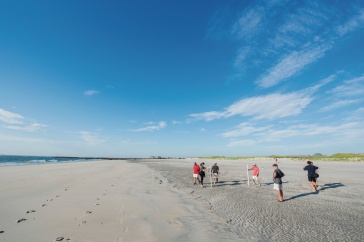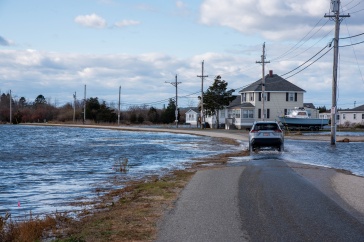
On New Hampshire’s Seacoast, rising seas could cause flooded roads in unexpected places: up to two miles inland, even as far as Pease Tradeport. That’s the finding from a team of UNH researchers who looked at the effect of rising groundwater caused by increasing ocean water levels. Flooding not only makes roads impassable in the short term, it can hasten roads’ failure in the future.
“The worst enemy of pavement is water. If the soil and substrate under the pavement get wet, then the strength that we had counted on to carry the traffic isn’t there anymore.”
Ordinarily, groundwater levels are higher than sea levels, so groundwater flows to the ocean. But as sea levels begin to rise, groundwater also slowly rises to maintain equilibrium, inching closer to the pavement base layers that need to stay dry to maintain their strength. “The worst enemy of pavement is water,” says Jo Sias Daniel, professor of civil and environmental engineering and director of UNH’s Center for Infrastructure Resilience to Climate. “If the soil and substrate under the pavement get wet, then the strength that we had counted on to carry the traffic isn’t there anymore. So the pavement develops ruts and cracks, allowing more water to get into the underlying layers, which makes the situation worse and can lead to roads being closed for long periods of time.”
Previous road vulnerability studies have looked at road surface flooding, but the UNH study, led by civil engineering doctoral student Jayne Knott, is the first to look at the role of groundwater in road compromise. “We found that the effects of surface water flooding on roads occur within a mile of the coast, and groundwater-rise effects can occur more than twice that,” Knott says.
Knott and a team that included Daniel, doctoral student Mohamed Elshaer, professor of civil and environmental engineering Jennifer Jacobs and Paul Kirshen of the University of Massachusetts, Boston, examined data from the N.H. Department of Transportation for the most endangered sections of five Seacoast roads: the Spaulding Turnpike, Portsmouth’s Gosling Road, Route 286 in Seabrook, Route 101 and Portsmouth’s Middle Street. They overlaid current and projected groundwater levels given various projected sea-level rise scenarios.
Understanding how to identify roads vulnerable to flooding is essential for pavement engineers and others to plan for the effects of a changing climate. Study results indicate that although Route 101 and the Spaulding Turnpike will probably not have many adverse issues from rising groundwater until late in this century, both Route 286 in Seabrook — an emergency evacuation route — and Gosling Road in Portsmouth will be vulnerable as groundwater levels continue to rise. Without drastic improvements to these routes, motorists can expect segments of these roadways to deteriorate more quickly, require more maintenance and be closed for longer periods of time.
Originally published in UNH Magazine Winter 2018 Issue
-
Written By:
Beth Potier | UNH Marketing | beth.potier@unh.edu | 2-1566




















































